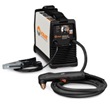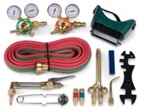Why not consider both?
If you spend much time with metal fabricators, hobbyists or anyone involved in the welding industry, you’re bound to hear an argument around which is better - plasma or oxy-fuel?
I grew up on a farm and like most farm shops at the time, we didn’t have a plasma cutter. We only had an oxy/acetylene torch outfit. The only place that had a plasma cutter was a local fab shop and after seeing it in action, we just had to get one! It was a significant investment, but we were impressed with the cut quality.
The new plasma cutter quickly took a place of honor in our shop as the oxy-fuel torch outfit got pushed back in the corner (thinking we may never use it again). This of course changed quickly when we realized the first order of business that day was a repair job that would involve heating and bending ½” steel. The oxy-fuel torch outfit came back out and took its rightful place beside the plasma cutter. The point is, no shop is complete without both tools so let’s discuss applications, advantages and limitations of each.
3 Question to point you in the right direction
- What type of metal do you normally cut?
- What is the thickest metal, within reason, that you'll ever cut?
- Do you need a tool for cutting only or do you also need heating, welding or brazing capability?
Plasma Cutting

Plasma cutting offers quick starts and fast cutting speeds on thin to moderate metals including aluminum and stainless steel. It is typically a clean cut, with minimal cleanup. Depending on input power and material thickness, plasma cutting speeds can range from 6 to 50+ inches per minute. As material thickness increases, the cutting speed advantage over oxy-fuel systems diminishes.
Another significant advantage of plasma is related to warpage. When cutting thin metals, heat produced in the oxy-fuel process can cause material to distort. A plasma cut produces a very narrow heat effected area minimizing warpage. This can be a big advantage when working with sheet metal thicknesses of 3/16” or less.
You will need an air compressor and primary power source to run the plasma cutter and air compressor. Initial set up cost just for a plasma cutter ranges from $850 - $1,700 depending on the maximum rated cut required. Hobart®’s line of AirForce® plasma cutters can clean cut from 1/8” up to 5/8” thick steel.
Add excellent cut quality, easy learning curve and the ability to cut almost any conductive material to the list above and it’s easy to see why a plasma cutter is an indispensable tool for a multitude of cutting and gouging applications.
Oxy-Fuel Systems

Cutting with an oxy-fuel system requires preheating carbon steel to kindling temperature (about 1600F) before hitting the cutting oxygen lever. There are (2) main types of handheld oxy-fuel torches - one piece (cutting torches) and two-piece (combination torches). One piece cutting torches are designed for cutting only. You should choose a combination torch if processes other than cutting are important to you.
On thicker material, oxy-fuel cuts can be much faster than plasma. For example, a 2” thick piece of carbon steel, requiring a 4” long cut would take a 120-A plasma cutter roughly 1 minute to complete the cut, while an oxy-fuel torch could make the same cut in 15-20 seconds. Combination torches can be configured with cutting attachments, heating, gouging or welding tips, specifically designed for multiple fuel gases, material thicknesses and applications.
Oxy-fuel systems are generally less expensive and more versatile. Oxy-fuel systems are more portable because they are fully self-contained. They do not require an electrical power source or an air compressor. As a general rule, oxy-fuel cutting is limited to carbon steel but cutting capacity can range from 1/8” to 22” or more.
You will need a fuel cylinder and an oxygen cylinder to run an oxy-fuel system anytime, anywhere. Initial set up cost for a typical medium duty oxy-fuel system is $230 - $500. Hobart offers a medium duty combination torch outfit that cuts up to 1/2” and welds up to 3/32” thick steel. Optional tips are also available that can cut up to 6” and weld up to 1-1/4” thick steel.
Final Thoughts
In the hands of a skilled operator, an oxy-fuel system capable of excellent cut quality, requires little maintenance, and consumable costs are relatively low. With proper setup, operation and flame setting, a single cutting tip can provide 50– 90 hrs. of cutting (or even more, depending on the operator and application). Plasma cutting on the other hand may require more upfront investment but offers quicker starts and can cut materials other than carbon steel like stainless, aluminum and copper. Both tools fill gaps and complement each other and both are indispensable. Whether you put your trust in an arc or in a flame, depends on what you do.
Author: Joe Beving - Cutting Expert w/40+ years of Experience